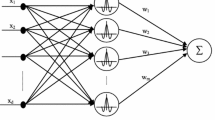Abstract
This study presents a wavelet-based neuro-fuzzy network (WNFN). The proposed WNFN model combines the traditional Takagi–Sugeno–Kang (TSK) fuzzy model and the wavelet neural networks (WNN). This study adopts the non-orthogonal and compactly supported functions as wavelet neural network bases. A novel supervised evolutionary learning, called WNFN-S, is proposed to tune the adjustable parameters of the WNFN model. The proposed WNFN-S learning scheme is based on dynamic symbiotic evolution (DSE). The proposed DSE uses the sequential-search-based dynamic evolutionary (SSDE) method. In some real-world applications, exact training data may be expensive or even impossible to obtain. To solve this problem, the reinforcement evolutionary learning, called WNFN-R, is proposed. Computer simulations have been conducted to illustrate the performance and applicability of the proposed WNFN-S and WNFN-R learning algorithms.
Similar content being viewed by others
References
Lin, C.T., Lee, C.S.G.: Neural Fuzzy Systems: A Neuro-Fuzzy Synergism to Intelligent System. Prentice-Hall, New Jersey (1996)
Towell, G.G., Shavlik, J.W.: Extracting refined rules from knowledge-based neural networks. Mach. Learn. 13, 71–101 (1993)
Lin, C.J., Lin, C.T.: An ART-based fuzzy adaptive learning control network. IEEE Trans. Fuzzy Syst. 5, (4), 477–496 (1997) (Nov)
Wang, L.X., Mendel, J.M.: Generating fuzzy rules by learning from examples. IEEE Trans. Syst. Man Cybern. 22, (6), 1414–1427 (1992) (Nov/Dec)
Takagi, T., Sugeno, M.: Fuzzy identification of systems and its applications to modeling and control. IEEE Trans. Syst. Man Cybern. SMC-15, 116–132 (1985)
Jang, J.S.R.: ANFIS: adaptive-network-based fuzzy inference system. IEEE Trans. Syst. Man Cybern. 23, 665–685 (1993)
Lin, C.J., Chin, C.C.: Prediction and identification using wavelet-based recurrent fuzzy neural networks. IEEE Trans. Syst. Man Cybern. B 34, (5), 2144–2154 (2004) (Oct)
Lin, F.J., Lin, C.H., Shen, P.H.: Self-constructing fuzzy neural network speed controller for permanent-magnet synchronous motor drive. IEEE Trans. Fuzzy Syst. 9, (5), 751–759 (2001) (Oct)
Takagi, H., Suzuki, N., Koda, T., Kojima, Y.: Neural networks designed on approximate reasoning architecture and their application. IEEE Trans. Neural Netw. 3, (5), 752–759 (1992)
Mizutani, E., Jang, J.-S.R.: Coactive neural fuzzy modeling. In: Proc. Int. Conf. Neural Netw., pp. 760–765 (1995)
Lin, C.J., Chin, C.C.: Prediction and identification using wavelet-based recurrent fuzzy neural networks. IEEE Trans. Syst. Man Cybern. B 34, (5), 2144–2154 (2004) (Oct)
Juang, C.F.: A TSK-type recurrent fuzzy network for dynamic systems processing by neural network and genetic algorithms. IEEE Trans. Fuzzy Syst. 10, (2), 155–170 (2002) (Apr)
Karr, C.L.: Design of an adaptive fuzzy logic controller using a genetic algorithm. In: Proc. 4th Conf. Genetic Algorithms, pp. 450–457 (1991)
Homaifar, A., McCormick, E.: Simultaneous design of membership functions and rule sets for fuzzy controllers using genetic algorithms. IEEE Trans. Fuzzy Syst. 3, (9), 129–139 (1995) (May)
Lee, M.A., Takagi, H.: Integrating design stages of fuzzy systems using genetic algorithms. Proc. IEEE Int. Conf. Fuzzy Syst. 1, 612–617 (1993) (Apr)
Lin, C.T., Jou, C.P.: GA-based fuzzy reinforcement learning for control of a magnetic bearing system. IEEE Trans. Syst. Man Cybern. B 30, (2), 276–289 (2000) (Apr)
Juang, C.F., Lin, J.Y., Lin, C.T.: Genetic reinforcement learning through symbiotic evolution for fuzzy controller design. IEEE Trans. Syst. Man Cybern. B 30, (2), 290–302 (2000) (Apr)
Ho, D.W.C., Zhang, P.A., Xu, J.: Fuzzy wavelet networks for function learning. IEEE Trans. Fuzzy Syst. 9, (1), 200–211 (2001)
Moriarty, D.E., Miikkulainen, R.: Efficient reinforcement learning through symbiotic evolution. Mach. Learn. 22, 11–32 (1996)
Jang, J.-S.R., Sun, C.T., Mizutani, E.: Neuro-Fuzzy and Soft Computing. Prentice-Hall, New York (1997) (Ch. 17)
Cordon, O., Herrera, F., Hoffmann, F., Magdalena, L.: Genetic Fuzzy Systems Evolutionary Tuning and Learning Of Fuzzy Knowledge Bases. Advances in Fuzzy Systems – Applications and Theory, vol 19World Scientific, New Jersey (2001)
Barto, A.G., Sutton, R.S.: Landmark learning: an illustration of associative search. Biol. Cybern. 42, 1–8 (1981)
Barto, A.G., Sutton, R.S., Anderson, C.W.: Neuron like adaptive elements that can solve difficult learning control problem. IEEE Trans. Syst. Man Cybern. SMC-13, (5), 834–847 (1983)
Wang, L.X.: Adaptive Fuzzy Systems and Control. Prentice-Hall, Englewood Cliffs, NJ (1994)
Wang, C.H., Wang, W.Y., Lee, T.T., Tseng, P.S.: Fuzzy B-spline membership function (BMF) and its applications in fuzzy-neural control. IEEE Trans. Syst. Man Cybern. 25, (5), 841–851 (1995) (May)
Farag, W.A., Quintana, V.H., Lambert-Torres, G.: A genetic-based neuro-fuzzy approach for modeling and control of dynamical systems. IEEE Trans. Neural Netw. 9, (5), 756–767 (1998) (Sept)
Lin, C.T., Lee, C.S.G.: Reinforcement structure/parameter learning for neural-network-based fuzzy logic control systems. IEEE Trans. Fuzzy Syst. 2, 46–63 (1994) (Feb)
Cannon Jr., R.H.: Dynamics of Physical Systems. McGraw-Hill, New York (1967)
Cheok, K.C., Loh, N.K.: A ball-balancing demonstration of optimal and disturbance-accommodating control. IEEE Contr. Syst. Mag. 7, 54–57 (1987)
Whitley, D., Dominic, S., Das, R., Anderson, C.W.: Genetic reinforcement learning for neuro control problems. Mach. Learn. 13, 259–284 (1993)
Hauser, J., Sastry, S., Kokotovic, P.: Nonolinear control via approximate input–output linearization: the ball and beam example. IEEE Trans. Automat. Contr. 37, 392–398 (1992) (Mar)
Ishibuchi, H., Nakashima, T., Murata, T.: Three-objective genetics-based machine learning for linguistic rule extraction. Inf. Sci. 136, (1–4), 109–133 (2001)
Ishibuchi, H., Nojima, Y.: Analysis of interpretability–accuracy tradeoff of fuzzy systems by multiobjective fuzzy genetics-based machine learning. Int. J. Approx. Reason. 44, (1), 4–31 (2007)
Author information
Authors and Affiliations
Corresponding author
Rights and permissions
About this article
Cite this article
Lin, CJ., Liu, YC. & Lee, CY. Supervised and Reinforcement Evolutionary Learning for Wavelet-based Neuro-fuzzy Networks. J Intell Robot Syst 52, 285–312 (2008). https://doi.org/10.1007/s10846-008-9214-9
Received:
Accepted:
Published:
Issue Date:
DOI: https://doi.org/10.1007/s10846-008-9214-9




